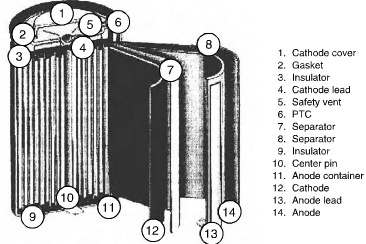Batteries: A battery is an electrochemical device used to store chemical energy and release it in the form of electricity and comprises two dissimilar metals forming the anode and cathode, which are immersed in an electrolyte that transmits ions.
Lithium ion batteries: Lithium is a light metal and can deliver a relatively high voltage, with a high capacity, holding twice the power when compared with a Ni-Cd or Ni-metal hydride battery on a weight basis and one and a half times on a volume basis. Moreover, it has no memory effect.
A problem initially experienced with rechargeable Li batteries was that during a recharge cycle, the Li metal tended to form dendrites that shorted the electrodes and limited the number of charge/recharge cycles. It also had an incipient fire risk. The problem was overcome by the development of Li ion cells based on Li intercalation compounds, which can donate or accept Li ions without depositing Li or any other solid.
Initially, Li batteries used a liquid electrolyte, necessitating the use of a robust case for safety. It is now used in the

fig.23.7-construction of a Li ion battery
ionized form. Figure 23.7 shows a typical Li ion cell utilizing a Li2O cathode and a carbon compound anode separated by a microporous membrane, using a non-aqueous electrolytes can be flammable, Valence Technology has developed the Li ion polymer battery using liquid lithium ion electrochemistry in a matrix of conductive polymers that eliminate free electrolyte within the cell.
A chemical reaction affecting cell safety can occur between a Li containing carbon and an electrolyte at high temperature under conditions of mechanical or electrical abuse.
MacNeil and Dahn, at Dalhousi University, believe that carbon fiber is a good candidate for the anode in Li ion cells, with the proviso that an efficient way of packing the fibers needs to be found which should offer optimum geometry for safety and performance.
Amorphous carbon fiber, appropriately heat treated, has a high discharging capacity for anode material in Li ion batteries. Pitch based carbon fiber has been used for anodes in Li rechargeable batteries.
Florida Atlantic University is investigating carbon fiber materials as potential anodes for reversibly storing Li, with the objective of developing a binderless electrode structure. Also work is on to use carbon fiber as the positive electrode material in which both cations and anions are reversibly inserted in carbonaceous materials.